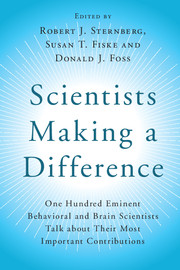 Scientists Making a Difference
Scientists Making a Difference Book contents
- Frontmatter
- Contents
- List of Contributors
- Foreword: Making a Creative Difference = Person × Environment
- Preface
- Part I Introduction
- Part II Biological Bases of Psychology: Genes, Brain, and Beyond
- Part III Cognition: Getting Information from the World and Dealing with It
- Part IV Development: How We Change Over Time
- Part V Motivation and Emotion: How We Feel and What We Do
- Part VI Social and Personality Processes: Who We Are and How We Interact
- Section A Social Cognition
- Section B Personal Relationships
- 80 The “Next One”
- 81 Human Mating Strategies
- 82 Love and Sex in the Marketplace
- Section C Group and Cultural Processes
- Part VII Clinical and Health Psychology: Making Lives Better
- Part VIII Conclusion
- Afterword: Doing Psychology 24×7 and Why It Matters
- Index
- References
81 - Human Mating Strategies
from Section B - Personal Relationships
Published online by Cambridge University Press: 05 August 2016
- Frontmatter
- Contents
- List of Contributors
- Foreword: Making a Creative Difference = Person × Environment
- Preface
- Part I Introduction
- Part II Biological Bases of Psychology: Genes, Brain, and Beyond
- Part III Cognition: Getting Information from the World and Dealing with It
- Part IV Development: How We Change Over Time
- Part V Motivation and Emotion: How We Feel and What We Do
- Part VI Social and Personality Processes: Who We Are and How We Interact
- Section A Social Cognition
- Section B Personal Relationships
- 80 The “Next One”
- 81 Human Mating Strategies
- 82 Love and Sex in the Marketplace
- Section C Group and Cultural Processes
- Part VII Clinical and Health Psychology: Making Lives Better
- Part VIII Conclusion
- Afterword: Doing Psychology 24×7 and Why It Matters
- Index
- References
Summary
My research obsession with mating started in the early 1980s. I sought to test several evolution-based hypotheses that derived from Darwin's 1871 theory of sexual selection. Darwin observed that many qualities of animals seem to have no survival advantage whatsoever. Think about the brilliant plumage of peacocks, the bulky antlers of male deer, or the loud mating croaks of frogs. Darwin's theory of sexual selection identified two critical causal processes by which these weird survival-impairing characteristics could evolve: preferential mate choice, and same-sex competition. Potential mates possessing qualities desired by one sex have a mating advantage; they get chosen, while those lacking desired qualities do not. Qualities linked with winning same-sex competitions also evolve, or get passed on in greater numbers, because victors gain increased sexual access to members of the opposite sex. I became fascinated with these causal processes of sexual selection. It struck me as awe-inspiring that so much evolutionary action revolved around mating, even though many erroneously see evolutionary theory as all about survival.
There were two problems. First, back in the 1980s I was not aware of any psychologists who actually used evolutionary theory to guide their empirical research. Second, although biologists were using sexual selection theory to make discoveries about insects and birds, next to nothing was known about these processes in humans. So I set out to test a few hypotheses about gender differences in the content of mate preferences – that men would prefer fertility in a mate, such as cues to youth and health; that physical appearance provides this bounty of cues; and that women would prefer potential mates who have resource-acquisition potential, in part to offset their large obligatory investment of a nine-month pregnancy (none of this is conscious, of course).
The results supported these predictions, but there was another problem. If the hypotheses anchored in sexual selection were correct, they should be universal, not just found among a couple of undergraduate samples. Over the next five years, I launched the International Mate Selection Project, and ended up assembling a team of fifty collaborators in thirty-seven countries occupying six continents and five islands. I knew that whatever I found would be controversial.
- Type
- Chapter
- Information
- Scientists Making a DifferenceOne Hundred Eminent Behavioral and Brain Scientists Talk about Their Most Important Contributions, pp. 383 - 388Publisher: Cambridge University PressPrint publication year: 2016
